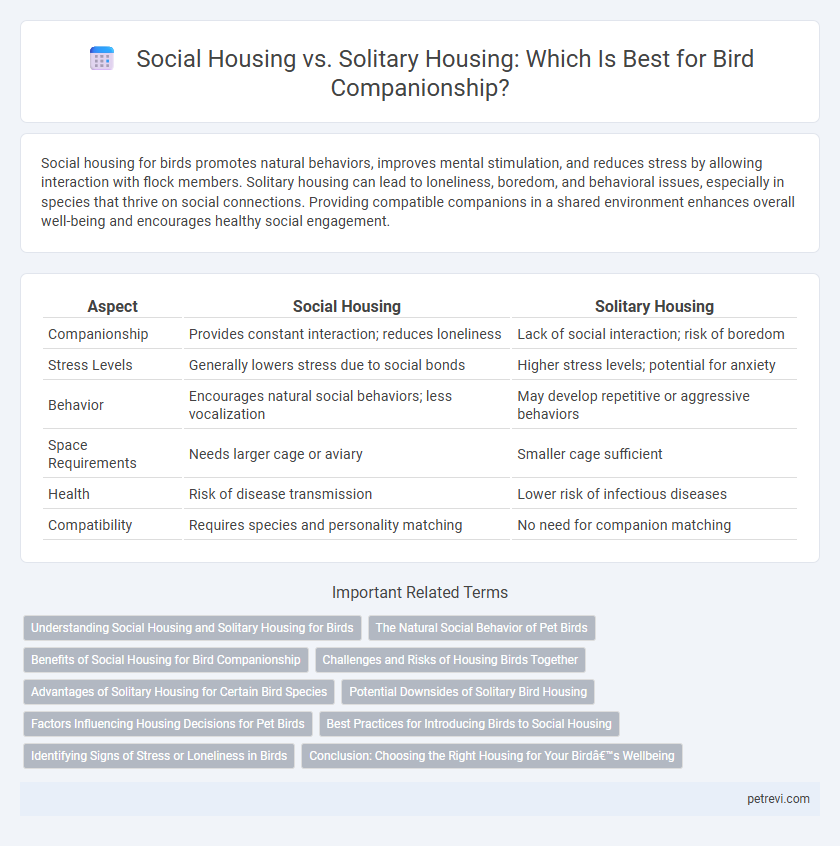Social housing for birds promotes natural behaviors, improves mental stimulation, and reduces stress by allowing interaction with flock members. Solitary housing can lead to loneliness, boredom, and behavioral issues, especially in species that thrive on social connections. Providing compatible companions in a shared environment enhances overall well-being and encourages healthy social engagement.
Table of Comparison
| Aspect | Social Housing | Solitary Housing |
|---|---|---|
| Companionship | Provides constant interaction; reduces loneliness | Lack of social interaction; risk of boredom |
| Stress Levels | Generally lowers stress due to social bonds | Higher stress levels; potential for anxiety |
| Behavior | Encourages natural social behaviors; less vocalization | May develop repetitive or aggressive behaviors |
| Space Requirements | Needs larger cage or aviary | Smaller cage sufficient |
| Health | Risk of disease transmission | Lower risk of infectious diseases |
| Compatibility | Requires species and personality matching | No need for companion matching |
Understanding Social Housing and Solitary Housing for Birds
Social housing for birds involves keeping multiple birds together in an environment that promotes natural social interaction, enhancing mental stimulation and reducing stress through companionship. Solitary housing, on the other hand, requires providing ample enrichment and interaction to prevent loneliness and behavioral issues since some bird species naturally prefer independence. Understanding species-specific social needs and behavioral tendencies is crucial for optimizing bird welfare in either housing setup.
The Natural Social Behavior of Pet Birds
Pet birds, such as parrots, cockatiels, and budgerigars, exhibit strong natural social behaviors that are best supported through social housing environments. These species naturally live in flocks, forming complex social bonds, communicating through vocalizations, and engaging in mutual preening, which helps maintain mental health and reduces stress. Solitary housing often leads to loneliness, behavioral problems, and increased risk of feather plucking or aggression due to unmet social needs.
Benefits of Social Housing for Bird Companionship
Social housing in birds enhances their mental stimulation, reducing stress and preventing behavioral issues such as feather plucking and excessive vocalization. Living in groups promotes natural behaviors like preening, foraging, and social interaction, which are critical for emotional well-being and cognitive development. Species like parrots and finches thrive with companions, experiencing increased longevity and overall health compared to solitary housing.
Challenges and Risks of Housing Birds Together
Housing birds together in social environments can increase risks of aggression, dominance struggles, and territorial disputes, potentially leading to stress and injury. Disease transmission is a significant challenge, as close proximity facilitates the spread of infections like psittacosis and avian flu. Incompatible species or personalities may cause chronic stress, impacting overall health and longevity.
Advantages of Solitary Housing for Certain Bird Species
Solitary housing benefits territorial bird species by reducing stress and aggressive behaviors often triggered by forced companionship. Birds such as certain parrots and raptors exhibit improved mental health and longevity when housed alone, as they maintain natural instincts without social dominance conflicts. Limited risk of disease transmission also supports solitary housing as a safer, more controlled environment for sensitive or solitary-natured birds.
Potential Downsides of Solitary Bird Housing
Solitary bird housing can lead to increased stress, behavioral issues, and weakened immune systems due to the lack of social interaction essential for many avian species. Birds kept alone may develop feather plucking, aggression, or depression, which negatively impact their overall well-being and longevity. In contrast, social housing often promotes mental stimulation, natural behaviors, and emotional health, highlighting potential downsides of isolation in solitary environments.
Factors Influencing Housing Decisions for Pet Birds
Factors influencing housing decisions for pet birds include species-specific social needs, behavioral tendencies, and space availability, which are critical in choosing between social housing and solitary housing. Birds with inherently social behaviors, such as parrots and finches, often thrive in social housing that promotes natural interaction, while solitary species may experience stress or aggression when housed with others. Caregiver experience, potential for disease transmission, and environmental enrichment also play essential roles in determining optimal housing conditions for bird companionship.
Best Practices for Introducing Birds to Social Housing
Introducing birds to social housing requires careful consideration of species compatibility, gradual acclimation, and observation to minimize stress and aggression. Best practices include setting up neutral spaces for initial meetings, providing multiple perches and feeding stations to reduce competition, and monitoring body language closely to identify signs of distress or acceptance. Successful social integration depends on patience, environmental enrichment, and ensuring that birds have adequate space to retreat if needed.
Identifying Signs of Stress or Loneliness in Birds
Birds kept in social housing environments often exhibit signs of increased vocalization or feather plucking, indicating potential stress or loneliness linked to social dynamics. In solitary housing, behaviors such as excessive sleeping, lack of appetite, or repetitive movements may signal isolation-induced stress or emotional distress. Monitoring changes in activity levels, plumage condition, and vocal patterns provides essential data for assessing avian well-being in both social and solitary settings.
Conclusion: Choosing the Right Housing for Your Bird’s Wellbeing
Selecting appropriate housing that matches a bird's social needs enhances mental stimulation and reduces stress-related behaviors, improving overall wellbeing. Birds with naturally social tendencies thrive in social housing environments where interaction promotes cognitive health, while solitary housing suits species that prefer solitude to prevent anxiety. Tailoring the living conditions to the bird's species-specific social habits ensures optimal behavioral balance and emotional stability.
Social housing vs Solitary housing for Bird companionship Infographic

 petrevi.com
petrevi.com